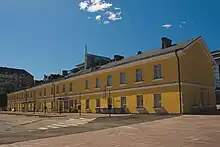Turku barracks
The Turku barracks was a barracks building for the military of Russia built in 1833 in Kamppi, Helsinki, Finland, along the street Läntinen Henrikinkatu (now known as Mannerheimintie).

Before construction
The Kamppi area had already been used under Swedish rule as a camping and practice area for the military, known as Campementsplats, where the name Kamppi comes from.[1] The area was later used by the Finnish Guard until it was taken into use by the Russian military settled in Helsinki.
Construction
The Turku barracks was constructed from 1830 to 1833 at the site of the current Lasipalatsi building, which was at the edge of the city proper at the time, near the Espoo toll station, which was the start of a highway leading to Turku. Before that, the Russian military in Helsinki had been mainly stationed in the Merikasarmi building in Katajanokka, which then was transferred to the use of the navy of the Military of the Grand Duchy of Finland.[2]
The original plans for the barracks were made by Carl Ludvig Engel, but it was built on a commission from Nikolai Sinebrychoff.[3] A number of side buildings were built on the west and southwest sides of the main building, and a large exercise field was built between them, at the site of the current Narinkka square.[1]
Destruction and subsequent use
During the Finnish Civil War, in connection of the conquest of Helsinki on 12 April 1918, the Turku barracks caught fire and was almost completely destroyed.[4] It was not rebuilt, but instead dismantling started the next year,[3] even though some of the ruins remained up to the 1930s.[2]
The remaining side buildings near the barracks were in use in the Finnish Defence Forces in the 1920s, housing the Uusimaa Dragoon Regiment, the command company and the Field Artillery Regiment 1.[5] Nowadays almost all of them have been dismantled, some of the brick buildings along Fredrikinkatu only in the 1950s.[3] Only the economics building west of the main building remains, which was in operation from 1935.[2] Up to the completion of the Kamppi Center in 2005 this building served as Helsinki's main bus station. Nowadays it houses restaurants and the Laituri exhibition space of the city's zoning bureau. The exercise field was used as a sports field and a skating rink in the 1930s.[1]
The Finnish state donated the Turku barracks to the city of Helsinki in an exchange in 1934.[2] The next year, after it had been destroyed, the Lasipalatsi building, originally intended as a temporary building, was built in its place.[1][3]
References
- Kaija Ollila, Kirsti Toppari: Puhvelista Punatulkkuun, Helsingin vanhoja kortteleita, pp. 208–209. 8th edition. Sanoma Oy, 1998. ISBN 951-9134-69-7.
- Turun kasarmin tontille linja-autoasema, Lasipalatsi. Accessed on 12 April 2012.
- Kampin kasvot kautta aikojen, City Museum of Helsinki. Accessed on 12 April 2012.
- Laura Kolbe, Samu Nyström: Helsinki 1918, Pääkaupunki ja sota, p. 87. Minerva Kustannus Oy. ISBN 978-952-492-138-1.
- Asmo Alho, Uljas Rauanheimo: Helsinki ennen meitä, Vanhojen kuvien kertomaa. Otava, 1962.
External links
- Häviävää Helsinkiä - Turun kasarmin raunioita hajoitetaan, Suomen Kuvalehti 22 February 1919, issue #8, p. 15, Digital archives of the Finnish National Library